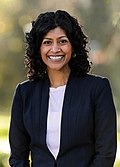Top Qs
Timeline
Chat
Perspective
List of Asian Australian politicians
From Wikipedia, the free encyclopedia
Remove ads
This is a list of Asian Australians who have served as members of Australian federal, state, or territory legislatures. Despite Australia's proximity to Asia, as well as the significant and increasing minority of Australians belonging to an Asian ethnicity,[1][2] the Australian Parliament is considered to be particularly under-representative of its constituents of Asian descent in comparison to other Western multicultural democracies[3][4][5] with members of minority groups making up only about 6 percent of Parliament.[6]
Remove ads
Classification
Summarize
Perspective
The term Asian Australian was first coined in the 1950s by European Australians who sought to strengthen diplomatic and trade ties with Asia. However, the term was not originally used to describe or recognise the experiences of people of Asian descent living in Australia. It was not until the late 1980s and 1990s that the term was adopted and used by Asian Australians themselves to discuss issues related to racial vilification and discrimination. Today, the term is widely accepted and used to refer to people of Asian descent who are citizens or residents of Australia, although its usage and meaning may vary within the Asian Australian community.[7]
When people use the term Asian in everyday conversation, they are usually referring to two main groups: East Asians (including Chinese, Japanese, Korean, and Mongolian) and Southeast Asians (including Filipinos, Cambodians, Vietnamese, Laotians, Indonesians, Thais, and Singaporeans). Additionally, South Asians (including Indians, Bangladeshis, Sri Lankans, Nepalese, and Pakistanis) may also be included.[7]
Census definition
Information relating to the racial composition of the population was collected for the first time at the Census of 1911. The following were classified as "Asiatic":[8]
At censuses prior to 1966 the instructions relating to race were insufficient to enable respondents to classify themselves according to the degree of racial mixture. As one report for the 1966 Census of Population and Housing details:[9]
For example, from 1933 to 1961 persons were asked the following question:
"For persons of European race, wherever born, write "European ". For non-Europeans state the race to which they belong, for example, "Aboriginal", "Chinese", "Negro", "Afghan", etc. If the person is half-caste with one parent of European race, write also "H.C.", for example "H.C. Aboriginal", "H. C. Chinese", etc."At the 1966 Census the instructions were re-designed ... in an endeavour to obtain precise data on racial mixture and also to avoid the opprobrium attaching to the term "half-caste" ...
— 1966 Census (1971), "Population: Single Characteristics. Part 11", p. 7
The Australian Bureau of Statistics and Australian Census no longer collect data on race as a standalone category. Instead, they collect information on distinct ancestries, of which census respondents can select up to two. The ABS has classified certain ancestries into categories for the purposes of aggregating data, including:[10]
- North-East Asian (including Chinese, Koreans, Japanese, etc.);
- South-East Asian (including Vietnamese, Filipinos, Indonesians, etc.); and
- Southern and Central Asian (including Indians, Sri Lankans, Afghans, etc.).
Ancestry is the primary statistical measure of ethnicity or cultural origins in Australia. The different ancestry groups may have distinct histories, cultures, and geographical origins. Therefore, information on Australians with ancestry from Asia can be found in the respective articles for each separate article (e.g., Chinese Australians, Indian Australians, etc.).
It is important to note that Australians of Middle Eastern ancestries are not classified as part of the Asian category under the ABS's Australian Standard Classification of Cultural and Ethnic Groups (ASCCEG).[10] Instead, they are separately classified under North African and Middle Eastern. This includes Australians of Arab, Turkish and Iranian ancestries. However, Armenians, for example, are classified as Central Asian and therefore part of the Asian category.[11]Remove ads
Officeholders
Summarize
Perspective
20 Asian Australian people have been members of the Parliament of Australia (the Federal Parliament), including ten each in the Senate and the House of Representatives. The most common represented ethnicity are Chinese Australian (nine) and Indian Australian (three). There are eight incumbent Asian Australian parliamentarians as of 2022.
Federal Parliament
Senate
- First Asian-born migrant to be elected to Parliament
- First Asian-born member of Cabinet, First Asian-Australian foreign minister, and the first openly LGBTI person to hold the office
- First woman of South Asian heritage to be elected to Parliament
- First Muslim woman to attain any political office in Australia; first Muslim woman senator to be elected to Parliament
House of Representatives
State and local government
Governors
Australian Capital Territory Legislative Assembly
Parliament of New South Wales
Parliament of the Northern Territory
Parliament of Queensland
Parliament of South Australia
Parliament of Tasmania
Parliament of Victoria
Parliament of Western Australia
Councilors and Mayors
This section needs expansion with: more Asian Australian councillors, given there are hundreds of local councils in Australia. You can help by adding to it. (January 2023) |
Remove ads
See also
Asian Australians
Asian Americans
Other
Notes
- This article therefore does not list Australian politicians descended from the Middle Eastern region of Asia, such as Iranian Australian Senator Sam Dastyari, Turkish Australian Senator Mehmet Tillem, and Lebanese Australian MPs Bob Katter Sr., Daryl Melham, Bob Katter, and Michael Sukkar.
References
Wikiwand - on
Seamless Wikipedia browsing. On steroids.
Remove ads



























